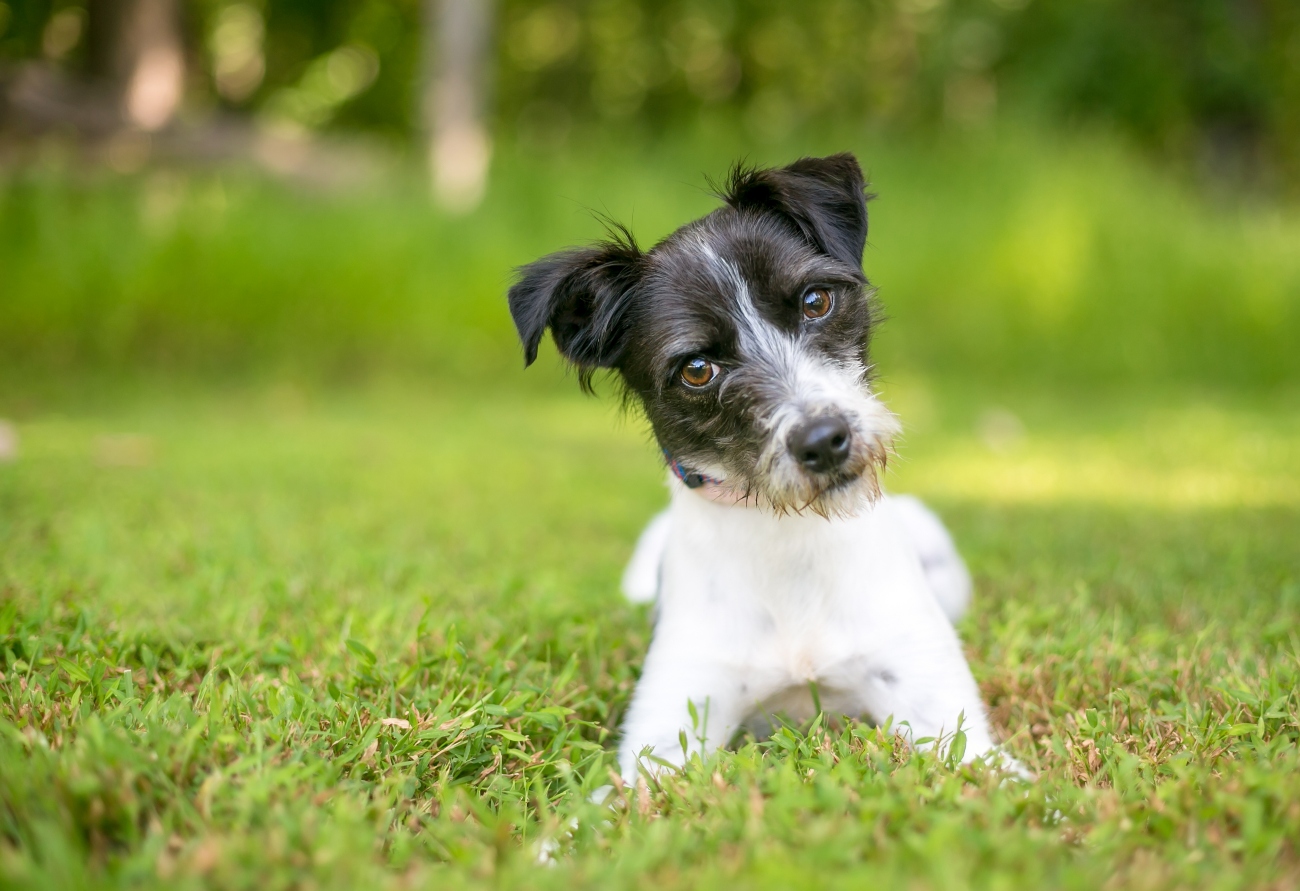Can dogs see colour?
25th May, 2023

Is your dog viewing the world in black and white or a whole kaleidoscope of colour? Learn what it looks like from their perspective and how their vision compares to ours.
It’s no secret that our four-legged friends are far superior when it comes to their sense of smell and hearing ability, but do they have the visual perception to match?
Sure, your beloved Fido might be good at hunting their favourite red ball in the middle of a green field, but maybe their nose leads them there rather than their eyes.
So, are dogs really colour blind? Or do they see the same colours as us?
Wouldn’t it be wonderful to see the world through their eyes? While there’s still more to learn about our dog’s vision, we’ll tell you everything we know so far.
Discover what your dog sees and how it compares to their other senses. We’ll also look at common eye concerns in canines and how animal insurance for dogs can help your faithful friend in an emergency.
Are dogs colour blind?
Have you always thought that canines see in black and white, without being able to distinguish the array of colours we can? While many pet owners still believe this is how their dog sees the world, science has shown this isn’t the case.
It turns out that your furry friend can see in colour – but not as many shades as we can or to the same intensity.
What colours can your dog see?
To truly understand the world from a dog’s eye view, we need to take a closer look at how vision (in both humans and canines) works.
Inside the retina, there are two types of photoreceptors:
- Cones: Responsible for what you see during the day and to distinguish between different colours.
- Rods: Help you see in dim light and at night by detecting grey shades and brightness.
As humans, we have three types of cones, allowing us to detect blue, red and green. Our canine companions, however, only have two types, meaning they can only see (probably) blue and a shade somewhere between green and red.
That doesn’t mean they can’t see as well, though. In fact, once the sun goes down, your four-legged friend can see better than any of us. Dogs might have fewer cones in their retina (5% compared to our 14%), but the higher percentage of rods means their night vision is something we can only dream of.
Precious peepers like these deserve the best protection from accidents and illness, so don’t forget to take out specialist animal insurance for dogs.
So, how does your dog see the world?
OK, we know they can’t see as many colours, but how else does their vision differ to ours?
Night vision
Let’s talk a bit more about what your pup sees in low light. As all the dogs we call our pets today likely evolved from wolves (hard to believe with a dachshund, we know), their vision has developed to help them hunt during dusk and dawn.
Ever noticed your dog’s eyes ‘shining’ in the dark? That’s because they have a reflective layer – the tapetum lucidum – that acts like a mirror and lets the retina get more than 50% of the light available. As a result, night time is a lot brighter to our furry friends than it is to us.
Wide peripheral vision
Your dog might not see the rainbow of colours we do, but they make up for it with an excellent field of vision. Our peripheral vision extends to 180 degrees. Sounds pretty good, right? Well, your pup can see an impressive 240 degrees – that’s an almost panoramic view of the world!
Their eyes are set wider apart on their head than ours, allowing them to see movement we’d have to turn our heads to spot.
Near sighted
It’s commonly believed that canines have 20/75 vision. What does it mean? Your pup can see fairly well up close, but the further away an object gets, the blurrier it becomes. Their sense of smell makes up for this, though, allowing them to sniff something out from very far away.
Want to know more about what your four-legged family member can see? We’ve got lots more facts in our article on what dogs see.
Can dogs see in the dark?
To a degree, yes. We’ve mentioned their excellent night vision capabilities, but this is with the help of a little moonlight. If you leave your pup in complete darkness, they won’t be able to see any better than we can.
That’s why it’s a good idea to keep your curtain ajar or hall light on for your dog at night. They’ll be able to find their water bowl easily and avoid tripping over something, which could otherwise see you claiming on your animal insurance for dogs because of an accident!
Can dogs watch TV?
Some pups ignore the TV completely, but others seem to watch, mesmerised by the colours and even barking at or following things on the screen. Sure, the sound plays a big part of your dog’s cinematic experience, but the images also have an impact.
In the past, canines didn’t pay much attention to what was on, but they’re much more likely to join you for a binge-watching session nowadays. Why?
Your dog’s eyes have a higher flicker rate than yours, which means they can only see a clear image above 70 frames per second (it’s 60 per second for humans). A higher resolution, modern TV is much easier for a canine to see than an older television set, hence the reason they never used to pay much attention to your favourite show.
So, don’t be surprised if Rover joins you on the sofa for an evening of entertainment – just keep an eye on your popcorn!
Do some dogs have better vision than others?
Yes, a few breeds that were originally bred for hunting by sight and speed (known as sighthounds) have a very impressive visual periphery of 270 degrees. Their panoramic vision is thanks to a high concentration of cones, allowing them to scan significant distances for prey.
It appears to be most common in dogs with long noses, like basenjis, greyhounds and Rhodesian ridgebacks. Don't leave it to chance, learn more about dog insurance here.
Common canine eye problems

Your dog’s eyes are pretty powerful, especially in low light, but that doesn’t mean they’re not susceptible to medical issues like us.
There are various common eye concerns that your dog is at risk of, and it’s your responsibility to make sure they get the medical attention they deserve when faced with a problem.
That’s why it’s so important to protect your pet with animal insurance for dogs before a condition develops. This way, you’ll be able to take them to the vet of your choice and make sure they get the best treatment possible.
Let’s take a closer look at common eye problem in dogs:
- Eye ulcers: These include wounds to the cornea (eye’s surface) and can visually impair your pup. Get them to the vet as soon as you notice an issue for treatment and to prevent complete loss of vision.
- Eye infections/conjunctivitis: These common problems are due to bacteria or viruses but can easily be treated. If your dog regularly suffers from infections, it might be because of an underlying cause.
- Cherry eye: This condition gets its name from the small, red lump that develops in the corner of your dog’s eye. It happens when the gland inside its third eyelid protrudes, which can be surgically removed. Find out which breeds are more at risk elsewhere on our site.
- Dry eye: If your furry friend has a severe lack of tear production, they can suffer from lots of pain, conjunctivitis, ulcers and even vision loss. The condition usually requires lifelong care, which can cost a small fortune without animal insurance for dogs in place.
- Cataracts: If your pup gets diagnosed with this issue, it means the eye’s lens has become cloudy. Over time, their vision reduces and often leads to blindness.
- Eyelash problems: Sometimes dogs' eyelashes grow the wrong way and others even have a whole extra set! This can cause rubbing on the eye’s surface and irritation, which they’ll need treatment for.
- Glaucoma: Increased pressure inside the eye is called glaucoma. It can be very painful for your pooch and cause blindness if it goes untreated.
- Blindness: There are a host of reasons why your dog could go blind, but they’re better at adapting to it than us.
- Masses and tumours: You might spot lumps and bumps on or around your dog’s eye. It’s crucial you get these checked out as soon as you notice them in case it’s something serious and they need to be removed.
How can I tell my dog is going blind?
The thought of your loyal companion going blind is a sad one, but loss of sight doesn’t mean your dog can’t enjoy a good quality of life anymore. How can you tell your beloved pooch can’t see as well as they used to?
- Clumsiness
- Change in the eye’s appearance
- Bumping into things
- Easily startled/nervous
- Walking more slowly and being cautious
- Seeming lost on walks
- Confused and disoriented
- Staring blankly at the wall/into space
- Not wanting to go outside
- Not able to find toys/food bowl
You’ll need to contact your vet as soon as you notice changes to your dog’s eyes or their behaviour in general. Remember, by investing in animal insurance for dogs while your pet is still healthy, you’ll have all the support you need to get them the best care and treatment.
What causes blindness in dogs?
There are various causes of canine blindness – some are treatable while others cause irreversible damage. Possible reasons for vision loss include:
- Glaucoma
- Cataracts
- Retinal disease
- Optic nerve disease
- Serious eye injury
- Tumours in the eye
- Other disease elsewhere in the body
If your pet loses their eyesight gradually, it can be harder to notice but they’ll be able to adapt better. Sudden loss of vision is much more obvious, and your pup might appear frightened and walk extremely cautiously.
You’ll need to discuss your dog’s quality of life and what the outlook is when deciding on a treatment plan together with your vet.
Tips on caring for a blind dog
If your dog is going blind or has total vision loss, you’ll need to make a few changes to your home and lifestyle to help them adapt. Many blind canines go on to live a full and happy life, but they need your support every step of the way.
Don’t make any sudden changes
With time, your blind dog will soon start to find its way through doors and around your home, so don’t make any drastic changes that could throw them off. Make sure their food and water bowls are easily accessible, so they don’t go hungry or thirsty.
If you do decide to move furniture around or even move home, guide them around the new items or through the new layout a few times to help them get used to it.
Pet-proof your house
After diagnosis, take a good look around your home. Are there any hazards that a blind dog won’t notice? Be extra mindful of:
- Sharp edges
- Electrical wires
- Stoves and fireplaces
Tuck cables away and make sure your dog can’t get near the dangerous hot hazards. You can add padding to sharp table edges to avoid accidents.
Be careful on walks
Just because your dog is now blind, it doesn’t mean they no longer wants to run around and explore while on walks. Make sure you avoid difficult terrain and keep them on a lead when away from home.
To satisfy their need to explore, you can invest in an extendable lead so they have a bit more freedom.
How does your dogs’ sight compare to their other senses?
Your beloved hound has the same five senses as you. Some are far superior, while others don’t match up to us. We’ve already talked about how their sight for colour isn’t as good as ours but their night time vision is significantly better.
Let’s see how their other four senses fair:
Smell
We’re all familiar with how incredible a dog’s sense of smell is. It’s especially outstanding in certain breeds like German Shepherds and bloodhounds.
The part of your pet’s brain that is used to smell is around 40 million times larger than ours! This canine super sense means they get used to sniff out toxic substances, explosives and drugs, as well as track missing persons. They may even be able to smell when you’re stressed!
So, what happens when a dog loses their ability to smell? Known as anosmia, a decreased sense of smell can be hard to diagnose, especially in regular household pets.
For police dogs and other working canines, we usually notice it affects their work, but what can you look for at home? You might see your pet become pickier at dinnertime or start behaving strangely in general – but this can also be a sign of a host of other health issues.
The best thing you can do as its doting pet parent is to give your vet a call. They’ll be able to check your dog and run tests if necessary to diagnose the problem. Don’t worry about vet bills piling up – your animal insurance for dogs can help with that.
Hearing
Another one of your dog’s best senses is its hearing. Despite being born deaf (puppies can’t hear until they’re 21 days old), once their hearing develops, it’s far superior to ours.
Compared to a person with normal hearing, your canine can detect sounds from four times the distance! They also hear at a much higher frequency. While it’s tough for us to pick up anything over 23,000 Hertz, our four-legged friends can hear up to 45,000 Hertz.
Unfortunately, many older dogs start to lose their hearing as they age, and it’s usually easier to notice than when their smell dissipates. Watch for:
- Less obedient and attentive
- Unresponsive to everyday sounds (doorbell, vacuum cleaner)
- Not responding to their name
- Difficult to wake up
- Barking excessively
- Shaking and tilting their head
- Less active than normal
There’s no real cure for deafness in dogs, but you can help them adjust to their new way of life. Canines still have other super senses to help them navigate, and you can train them with hand signals and other visual cues to get their attention.
Got some questions about adapting to your dog’s hearing loss? If you have animal insurance for dogs with Purely Pets, you can use our vet video consultation service 24-hours a day for quick, professional advice.
Taste
We’ve all seen our dogs smacking their lips as we serve up a Sunday roast, but do they savour the flavour as much as we do? No, they don’t. In fact, their sense of taste is far worse than ours.
On our tongues, we have around 9,000 taste buds. Dogs have just 1,700. That means their taste is only one sixth as powerful as humans. Canines can still tell the difference between savoury, sweet and bitter foods, but the speed at which they gulp food down shows us they aren’t really ‘enjoying’ the flavour.
Luckily for them, smell and taste are very closely related, so their nose plays a big role in their eating experience. This is why they’ll go off their food quicker when they lose their sense of smell rather than taste.
Touch
The first sense your dog develops after entering the world is touch. They might not have fingers like we do, but sensitive nerve endings across their body mean they feel things similarly to humans. That’s why they love a good cuddle and a tickle on their tummy and why they also feel pain.
Look closely at your pet’s face, and you’ll see whiskers on their muzzle, jaw and above their eyes. These help your dog navigate with their inferior eyesight and mean they can sense an object before they actually touch it. Fascinating, isn’t it?
Protect your pet with animal insurance for dogs

Your dog’s eyesight is pretty impressive. No, they can’t see in as many colours as we can, but they have excellent night vision and their periphery field is far more impressive than ours.
Just because your pup is armed with so many super senses, it doesn’t mean they don’t need you. In fact, your dog relies on you for just about everything, including their exercise, food and overall wellbeing.
As its loving pet parent, it’s your job to give them nutritional meals, plenty of walks and protect their health with animal insurance for dogs – that’s where Purely Pets can help.
We believe every dog deserves the best, and only offer lifetime plans for ongoing protection from as young as 8 weeks old.
Got a golden oldie you need to care for? With no upper age limit, you can find the right fit for you and your ageing companion with us.
To give your dog the care and treatment they need in an emergency, contact our team for award-winning pet insurance today.
Helpful Pages
Recent Posts
Pet Insurance Quote
- 98% claims paid *
- Claims paid directly to vets
- 24/7 vet video consultations
- Interest free monthly payments




